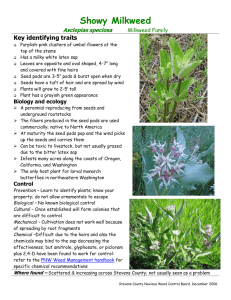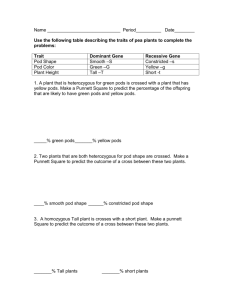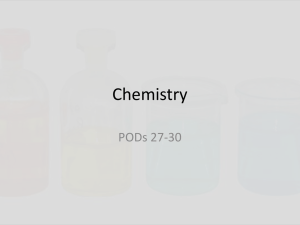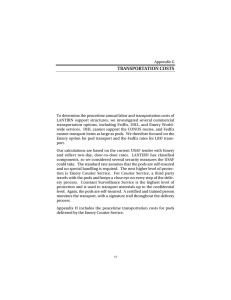Document 12948427
advertisement
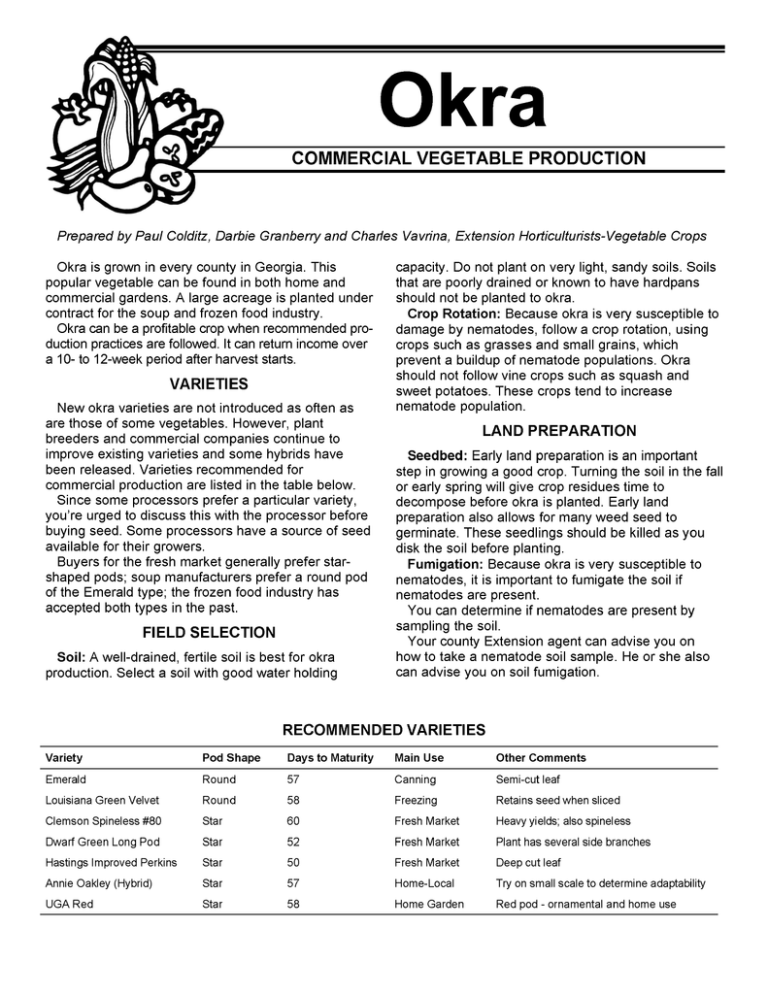
FERTILIZER Okra grows best on soils that have a pH of 5.8 to 6.5. A soil test will indicate if lime is required and will specify the amount of fertilizer to apply. If lime is recommended, use dolomitic lime. Apply it three or four months before the crop is seeded. Research indicates that okra should respond to additional phosphate when the soil test indicates medium to low phosphate. If your soil test indicates low phosphate, broadcast 400 pounds per acre of 20 percent superphosphate and disk it in. If the soil test indicates medium phosphate, apply 200 pounds per acre of 20 percent superphosphate and disk it in. If a soil test is not available, general recommendations are to apply 600 to 800 pounds per acre of a complete fertilizer such as 6-12-12 or 5-1015. This can be mixed under the row or applied in a band to the side. The okra plant has a sensitive balance between vegetative (foliage production) and reproduction (pod production). The use of additional nitrogen should be avoided on vigorous plantings until fruiting begins to check plant growth. Two or more sidedressings with a high analysis nitrogen material may be needed, however, depending on rainfall. It is important to supply additional nitrogen late in the season at the time the "forms" or "blooms" are concentrated in the top of the plant. Put down 33 pounds of additional nitrogen per acre at each application. your county Extension agent and the Georgia Pest Control Handbook for control measures. Diseases: Nematodes can cause serious losses in okra. Root-knot nematodes can be controlled by the use of approved nematicides. Nematicides are very essential if soil is infested with nematodes. Refer to the Georgia Pest Control Handbook and consult with your county Extension agent for approved control measures. The incidence of Fusarium wilt is much greater when root-knot nematodes are present. Nematode control is a major practice in reducing Fusarium wilt presence. HARVESTING The most important step in any okra operation is harvesting the pods correctly and at the proper time. Harvesting methods vary according to the market type. Harvesting for Processing: Most varieties grown for processing produce pods on a brittle stem. These pods can be broken or snapped in a manner that leaves the stem on the plant and not on the pod. Okra grown for processing should be allowed to get as long as possible without becoming fibrous or hard. As long as the pod tip will snap off evenly the pod is usually still tender. PLANTING Seed the okra after the soil has warmed enough to allow good germination. Space rows 28 to 38 inches apart. These spacings will require 12 to 15 pounds of seed per acre. Plant 1½ to 2 inches deep, 4 to 6 seed per foot. Thin to 8 to 12 inches between plants. Corn planters, such as the Cole planter, can be used for okra if the seed plate and cog are changed to plant this size seed. Planet Jr. type of seed planter is also suitable. PLANT PEST CONTROL Weeds: Weeds can be controlled by cultivation or by use of herbicides. Early weeds can be controlled by preplant herbicide applications. Later in the season, shallow cultivations can be used to control weeds. Refer to Extension Circular 695, Weed Control in Vegetables. Insects: At times it will be necessary to control insects that attack okra. Check your crop on a regular schedule, especially early in the season. This is the time that aphids usually appear. Later on, the plants and pods may be attacked by green stink bugs, cabbage loopers, corn earworms, European corn borers, and the leaf-footed plant bug. Consult with Processing: Two- to 4-inch pods left to mature one to two days longer will yield about 21/3 times more weight. If left to mature three to four days longer, they will yield about 3½ times more weight. Usually three harvests a week are required with process type of okra. Train your picking crews to grade okra as it is being harvested, discarding tough and damaged pods. Do not gather pods under 4 inches long. If left to reach maximum length, these pods will return a much greater weight per acre. Harvesting for Fresh Market: Greater care is necessary in harvesting okra for the fresh market. Grading standards are more exact and the pods must usually be cut with a knife. Fresh market okra is usually graded into these sizes: • Fancy - Pods up to 3½ inches long. • Choice - Pods 3½ to 4½ inches long. • Jumbo - Pods over 4½ inches but still tender. Be sure your picking crews are careful to neatly trim the stem end; this can be done as the pod is cut from the plant. To keeps pods small enough to grade as Fancy or Choice it will be necessary to harvest every day during periods of rapid growth. Caution: Any mature pods left on the plant will reduce future yield. It is very important that all mature pods be removed from the plants as soon as possible. The practice of cuffing off (cropping) leaves during harvest does not influence future yields as long as leaves are not cut above where pods have not developed. Fresh Market: Pods develop extremely fast. From bloom to Jumbo size takes only about eight days. To get a maximum of Fancy and Choice pods (groups 3 & 4), you must harvest every day. Trade and brand names are for information. The Cooperative Extension Service, University of Georgia College of Agricultural and Environmental Sciences, does not warrant the standard of any product mentioned; neither does it imply approval of any product to the exclusion of others which may also be suitable. Circular 627 Reviewed April, 2009 The University of Georgia and Ft. Valley State University, the U.S. Department of Agriculture and counties of the state cooperating. Cooperative Extension, the University of Georgia College of Agricultural and Environmental Sciences, offers educational programs, assistance and materials to all people without regard to race, color, national origin, age, gender or disability. An Equal Opportunity Employer/Affirmative Action Organization Committed to a Diverse Work Force
